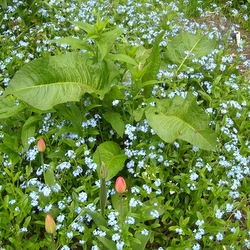Can you help us and identify this plant please?
Posted by Fiona Nevile in Flowers, General care | 17 comments“Did you know that you’ve got a giant dock weed growing in the herbaceous border?”
“Well yes and no. I thought it might be a dock at first but its leaves are larger and curly.”
Danny picked a regular dock leaf and compared them. Same colour, similar veins. The dock leaf was much smaller, without the grandiose frills.
I nipped inside and searched online for a plant with dock like leaves and found several possibilities but I would really like to know exactly what this plant is.
It needs to be moved as it is dominating a newly planted bush rose. It clearly is a relation of the dock family, some kind of sport perhaps?
This is the first time that Danny and I have had an active discussion over a plant – rather than the ‘those tulips are so pretty’ sort of clucks.
Danny loves our garden but isn’t interested in gardening per se. That is fine with me as it means that I can do whatever I like with the garden. But we are planning to start our “cut your own flowers” in a few weeks time.
“You must find out what the plant is before then,” Danny urged. “If it is a flowering plant you can say that it’s Novamerodockus Popularis – or whatever it’s called. Otherwise people will think it’s a giant weed.”
Now what garden doesn’t have weeds! I’m nurturing my dandelions to make wine again this year. At least that is what I’ve told Danny!
Leave a reply






As you hadn’t been able to ID it, my first thought was an ornamental – polygonum amplexicaule (Firetail) maybe.
Then I saw the other replies on Twitter which suggested rumex acetosa – this is bog standard kitchen garden Sorrel – nibble a teeny bit and if it was the distinctive acidic sorrel taste.
Horseradish! I think you would have got a whiff of it if you’ve bruised the leaves! Could be but doesn’t look crinkly or butch enough to me.
I’d go for a Dock – Broad Leaf Dock (Rumex obtusifolius) probably, that is enjoying your enriched soil!
Celia
x
I believe it’s horseradish, too. Looks like ours, anyway.
Our local farmshop were selling at mega money per root – something like £6 each! Don’t dig it up – sell it at your gate!!
Lucky you if it is horseradish! I’ve been hunting for a decent root of it for months.
I agree with Old Codger, horseradish snapped off and smelt definitely smells different to dock, much sweeter. It whiffs of something you could eat but dock never strikes me like that. I know what he means about being a menace to get rid of once it is established though. I was forever pulling it out of my herb bed
Horseradish or a Dock that is getting way larger as it is gorging on all the good things in the soil in your rose border instead of starving in a grass verge.
I’d need a close-up to be sure.
Horseradish was what came to my mind, too.
My instinct was to suggest Horseradish as well.
According to John Wright the two options are dock and horse radish – no dangerous concerns. He goes on to say that Dock has a little bit of red about it- it’s not no vivid a shade of green, dock doesn’t have such distinct fish bone vein markings and the base of the stem doesn’t exude a white fluid that tastes of horseradish… That last one seems a pretty good identifyer.
October time is the best time to harvest the roots and his description of preparing them is pretty amusing – you grate them – he says “I have never been caught in a tear gas attack, but I can’t imagine it’s as bad as grating horseradish”
Fingers crossed for you!
99% sure it is horseradish.
No need to dig up the root though to identify it. Just snap off a stalk near the base and have a sniff or nibble. You will soon know if it is Horseradish.
If it is Horseradish be warned – it spreads and is quite hard to get rid of once established. However this may be fine if you like roast beef as freshly grated horseradish makes a sauce a million miles from the supermarket version in jars.
Giant dock-like leaves could be horseradish. The horseradish growing along the path in work are re-growing after the winter and it looks similar. If you decide to dig up the root, you’ll be able to identify it with 100% certainty.